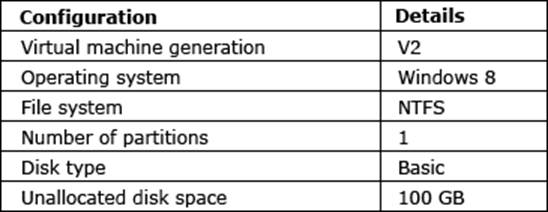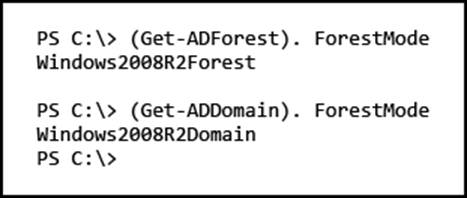Microsoft 70-740 Installation, Storage, and Compute with Windows Server 2016 Online Training
Microsoft 70-740 Online Training
The questions for 70-740 were last updated at Jan 12,2025.
- Exam Code: 70-740
- Exam Name: Installation, Storage, and Compute with Windows Server 2016
- Certification Provider: Microsoft
- Latest update: Jan 12,2025
Note: This question is part of a series of questions that use the same similar answer choices An answer choice may be correct for more than one question in the series Each question is independent of the other questions in this series. Information and details provided in a question apply only to that question.
You have a two-node Hyper-V cluster named Cluster1
As virtual machine named VM1 runs on Cluster1
You need to configure monitoring of VM1. The solution must move VM1 to a different node if the Print Spooler service on VM1 stops unexpectedly
Which tool should you use?
- A . the clussvc.exe command
- B . the cluster.exe command
- C . the Computer Management console
- D . the configurehyperv.exe command
- E . the Disk Management console
- F . the Failover Cluster Manager console
- G . the Hyper-V Manager console
- H . the Server Manager Desktop app
Note: This question is part of a series of questions that use the same similar answer choices An answer choice may be correct for more than one question in the series Each question is independent of the other questions in this series. Information and details provided in a question apply only to that question
You have three servers named Server1, Server2. Server3 that run Windows Server 2016 Server1 and Server2 have the Hyper-V server role installed Server3 has the iSCSI Target Server role service installed.

You need to create a Hyper-V cluster
Which tool should you use first?
- A . the clussvc.exe command
- B . the cluster.exe command
- C . the Computer Management console
- D . the configurehyperv.exe command
- E . the Disk Management console
- F . the Failover Cluster Manager console
- G . the Hyper-V Manager console
- H . the Server Manager Desktop app
Note: This question is part of a series of questions that use the same similar answer choices. An answer choice may be correct for more than one question in the series Each question is independent of the other questions in this series. Information and details provided in a question apply only to that question.
You have two servers named Server1 and Server2 that run Windows Server 2016 Server1 and Server2 have the Hyper-V server role installed.
An iSCSI SAN connects to the network.
You create a LUN on the SAN and configure both servers to connect to the iSCSI target
You create a failover cluster and add Server1 and Server2 to the cluster. You connect both servers to the iSCSI target and format the shared storage.
You need to add the shared storage to the cluster. The solution must ensure that virtual machines running on both nodes can access the shared storage
simultaneously.
Which tool should you use?
- A . the clussvc.exe command
- B . the cluster.exe command
- C . the Computer Management console
- D . the configurehyperv.exe command
- E . the Disk Management console
- F . the Failover Cluster Manager console
- G . the Hyper-V Manager console
- H . the Server Manager Desktop app
Note: This question is part of a series of questions that use the same similar answer choices An answer choice may be correct for more than one question in the series Each question is independent of the other questions in this series. Information and details provided in a question apply only to that question You have a two-node Hyper-V cluster named Cluster1 at a primary location and a stand-alone Hyper-V host named Server1 at a secondary location
A virtual machine named VM1 runs on Cluster1
You configure a Hyper-V Replica of VM1 to Server1
You need to perform a Test Fai lover of VM1.
Which tool should you use?
- A . the clussvc.exe command
- B . the cluster.exe command
- C . the Computer Management console
- D . the configurehyperv.exe command
- E . the Disk Management console
- F . the Failover Cluster Manager console
- G . the Hyper-V Manager console
- H . the Server Manager Desktop app
Note: This question is part of a series of questions that use the same similar answer choices. An answer choice may be correct for more than one question in the series. Each question is independent of the other questions in this series. Information and details provided in a question apply only to that question.
You have an Active Directory domain that contains two Hyper-V servers named Server1 and Server2. Server1 has Windows Server 2016 installed. Server2 has Windows Server 2012 R2 installed.
Each Hyper-V server has three network cards. Each network card is connected to a different subnet. Server1 contains a dedicated migration network.
Server2 contains a virtual machine named VM5.
You plan to perform a live migration of VM5 to Server1.
You need to ensure that Server1 uses all available networks to perform the live migration of VM5.
What should you run1?
- A . the Mount-VHD cmdlet
- B . the Diskpart command
- C . the Set-VHD cmdlet
- D . the Set-VM cmdlet
- E . the Set-VMHost cmdlet
- F . the Set-VMProcessor cmdlet
- G . the Install-WindowsFeature cmdlet
- H . the Optimize-VHD cmdlet
Note: This question is part of a series of questions that use the same similar answer choices. An answer choice may be correct for more than one question in the series. Each question is independent of the other questions in this series. Information and details provided in a question apply only to that question.
You have a Hyper-V host named Server1 that runs Windows Server 2016. Server1 contains a virtual machine named VM1.
You need to ensure that you can use nested virtualization on VM1.
What should you run on Server1?
- A . the Mount-VHD cmdlet
- B . the Diskpart command
- C . the Set-VHD cmdlet
- D . the Set-VM cmdlet
- E . the Set-VMHost cmdlet
- F . the Set-VMProcessor cmdlet
- G . the Install-WindowsFeature cmdlet
- H . the Optimize-VHD cmdlet
Note: This question is part of a series of questions that use the same similar answer choices An answer choice may be correct for more than one question in the series Each question is independent of the other questions in this series. Information and details provided in a question apply only to that question
You have a Hyper-V host named Server1 that runs Windows Server 2016 Server1 has a dynamically expanding virtual hard disk (VHD) file that is 900 GB The VHD contains 400 GB of free space.
You need to reduce the amount of disk space used by the VHD.
What should you run?
- A . the Mount-VHD cmdlet
- B . the Diskpart command
- C . the Set-VHD cmdlet
- D . the Set-VM cmdlet
- E . the Set-VMHost cmdlet
- F . the Set-VMProcessor cmdlet
- G . the Install-WindowsFeature cmdlet
- H . the Optimize-VHD cmdlet
Note: This question is part of a series of questions that use the same similar answer choices An answer choice may be correct for more than one question in the series Each question is independent of the other questions in this series. Information and details provided in a question apply only to that question
You have a Hyper-V host named Server1 that runs Windows Server 2016 You plan to deploy several shielded virtual machines on Server1
You deploy a Host Guardian on a new server
You need to ensure that Server1 can host shielded virtual machines.
What should you run first?
- A . the Mount-VHD cmdlet
- B . the Diskpart command
- C . the Set-VHD cmdlet
- D . the Set-VM cmdlet
- E . the Set-VMHost cmdlet
- F . the Set-VMProcessor cmdlet
- G . the Install-WindowsFeature cmdlet
- H . the Optimize-VHD cmdlet
Note: This question is part of a series of questions that use the same similar answer choices An answer choice may be correct for more than one question in the series Each question is independent of the other questions in this series. Information and details provided in a question apply only to that question
You have a Hyper-V host named Server1 that runs Windows Server 2016 Server1 has a virtual machine named VM1 that uses a single VHDX file VM1 is configured shown in the following table

You plan to use VM1 as a virtual Machine Template to deploy shielded virtual machines You need to ensure that VM1 can be used to deploy shielded virtual machines
What should you run?
- A . the Mount-VHD cmdlet
- B . the Diskpart command
- C . the Set-VHD cmdlet
- D . the Set-VM cmdlet
- E . the Set-VMHost cmdlet
- F . the Set-VMProcessor cmdlet
- G . the Install-WindowsFeature cmdlet
- H . the Optimize-VHD cmdlet
In this section, you’ll see one or more sets of questions with the same scenario and problem Each question presents a unique solution to the problem, and you must determine whether the solution meets the stated goals Any of the solutions might solve the problem. It is also possible that none of the solutions solve the problem.
Once you answer a question in this section, you will NOT be able to return to it As a result. these questions will not appear in the review screen
Note This question is part of a series of questions that present the same scenario Each question in the series contains a unique solution Determine whether the solution meets the stated goals.
Your network contains an Active Directory forest named contoso.com. The forest contains a member server named Server1 that runs Windows Server 2016 All domain controllers run Windows Server 2012 R2 Contoso com has the following configuration

You plan to deploy an Active Directory Federation Services (AD FS) farm on Served and to configure device registration You need to configure Active Directory to support the planned deployment.
Solution You upgrade a domain controller to Windows Server 2016 Does this meet the goal?
- A . Yes
- B . No
Latest 70-740 Dumps Valid Version with 334 Q&As
Latest And Valid Q&A | Instant Download | Once Fail, Full Refund

